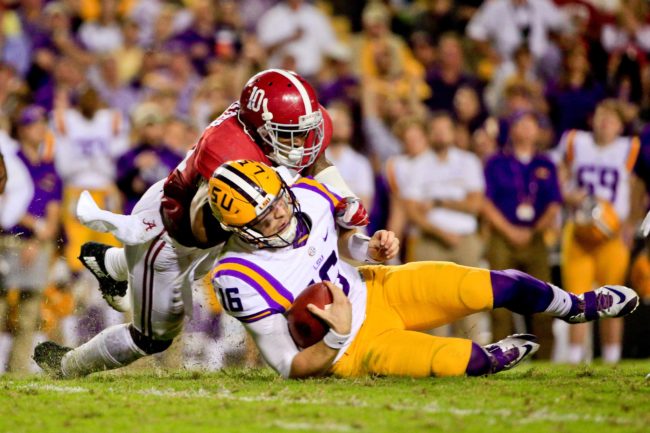
5 reasons Alabama beat LSU
Alabama’s 10-0 win against LSU wasn’t decided until the fourth quarter. Still, other factors played a critical role in the outcome of the defensive struggle in Death Valley. Here are five reasons why Alabama beat LSU:
- Alabama’s run defense: Leonard Fournette improved against last season’s performance … by four yards. He had 35 yards on 17 carries compared to 31 yards on 19 carries last season, so only slightly better. The Alabama defense held the entire LSU team to even fewer yards than last season (33 yards vs. 54 yards in 2015), and LSU actually had one more carry than last season (27 vs. 26 carries last season). Fournette had a few small gains but never broke free for an explosive gain.
- The Alabama running game: The team didn’t run the ball effectively in the first half but did well in the second half. Rushing the ball for 216 yards against this LSU defense is a strong performance. Entering this game, the LSU defense was allowing 104 rushing yards per game. Jalen Hurts fumbled the ball and threw an interception but came through by using his legs when Alabama needed him most. On a quarterback draw designed to get Alabama into field goal range, Hurts ended up getting a long first down on 3rd-and-15. The drive ended in a field goal anyway, but getting the first down helped Alabama use more clock time. In all, Hurts had 20 carries for 114 yards and the lone touchdown of the game. He averaged 5.7 yards per carry. Damien Harris and Bo Scarbrough also ran the ball effectively. Scarbrough averaged 4.7 yards per carry, while Harris averaged 4.4. Harris finished the game with 53 rushing yards, while Scarbrough had 52. Having three different rushing options made things more difficult for the LSU defense.
- Ronnie Harrison’s tip on LSU’s field goal attempt: LSU attempted a 49-yard field goal for potentially the first score of the game in the second quarter, but Harrison tipped the field goal, causing the kick to fall short. The stop played well for Alabama, helping the team feel better with a scoreless tie heading into halftime considering Adam Griffith later missed a 42-yard field goal attempt in the second quarter.
- Pressure and Minkah Fitzpatrick’s interception: Alabama applied pressure to Danny Etling throughout the game, totaling five sacks (two more than LSU had allowed in a game all season) and knocking Etling down on multiple plays. Ryan Anderson hit Etling on a pass that resulted in a Minkah Fitzpatrick interception. The ensuing Alabama drive resulted in a near-10 minute field goal drive that gave Alabama a 10-0 lead. Etling was 11-for-24, a 46 percent completion rate, and he had just 92 passing yards. If LSU wanted to defeat Alabama, the team needed more from Etling. However, he was constantly under pressure.
- Griffith’s field goal: Griffith’s 25-yard field goal was the final blow for LSU. Sure, the offense could have scored and a successful onside kick might have kept LSU in the game. However, for all practical purposes, with the way Alabama’s defense had dominated the LSU offense, the game was over when Alabama went ahead by two scores. Griffith didn’t have the best angle, but being in such a close range surely helped, especially since he missed earlier from 42 yards out.
